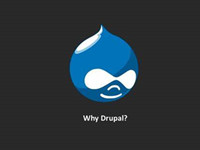Drupal is one of the most popular Content Management Systems around. Launched in 2000, it has a CMS market share of 4.7%, making it the third most used CMS after WordPress and Joomla. Used by numerous bloggers around the globe, Drupal is an open-source CMS written in PHP. In this article, we will look at the features offered by Drupal and also cover the steps to help a blogger get started on Drupal.
With the help of this information, you will be able to decide whether Drupal serves the purpose for your blog or not. There are some tips and tricks included in the article if you decide to go ahead with using Drupal for blogging.
Why Drupal is Good for Blogging?
- Open-source
Anyone can install and use Drupal without any costs. It is free to be used by any blogger or developer. You can also copy the code and modify it according to your requirements. Like most open-source software programs, the concept behind Drupal is to make its code available to the general public to be used freely, modified and even to contribute towards the development of Drupal by sharing your modifications.

- Flexible
Like most of the popular content management systems available today, Drupal is highly flexible. It gives beginners the opportunity to get started with themes even if they have very little experience about website development or design. At the same time, it gives seasoned developers the ability to code their website according to their requirements. Such versatility makes Drupal a choice CMS for many bloggers. Drupal, however, is not very suitable for beginners with no knowledge about web development. It is likely that such bloggers would have to hire a developer to build their website on Drupal.
- Strong community support
Since Drupal is an open-source CMS, community support plays an important role. While there are lots of tutorials and helpful videos that you can access, an active community makes it easy for users to ask questions and get answers quickly if they are stuck with some design element or coding problem. Drupal has been around for nearly two decades and has a very vast user base. There are nearly 1000 developers and 600,000 users on their official community, Drupal.org.
- Excellent security
Cyber security is a big concern for big and small website owners. As bloggers, you may have important information on your website, which can be misused if your website’s security is breached. Drupal’s security team ensures that all security risks are minimized by placing extensive security measures at various levels of the framework. Drupal also provides its users with security best practices, which can reduce security incidents from affecting your blog site.
- SEO friendly
In recent years, SEO has become extremely important for websites because of the growing internet real estate. With more and more people starting a new website on the internet every day, it is important to keep SEO in mind while building a blog.

Drupal blogs feature a permalink which is known to boost the website’s SEO ranking. At the same time, users can use Apache’s URL-rewrite to create friendly URLs for their audience and search engines. There are many other ways in which Drupal provides blogs the ability to rank higher on search engines, please refer to Drupal SEO modules to know more.
- Responsive themes
Since your audience may be spread across different screen sizes, it is important to ensure that you use a CMS that enable responsiveness of your blog so that it can adapt to different screen sizes. For bloggers, mobile phone responsiveness is peremptory.
Drupal is mobile-ready so your audience will not face problems when viewing your blog site on different screen sizes.
- Updated regularly
For any CMS to offer quality features and excellent user experience, it is important to regularly update the technologies used by it. Drupal stays competitive in the CMS market by offering regular updates which fix known bugs or problems and provide new features to its customers. At this time, Drupal 9 is the latest version available.

With these features, Drupal is able to attract a considerable audience of bloggers. Additionally, Drupal powers a lot of other websites for small and large businesses alike. It has also been the choice CMS for government websites like that of the State of Colorado.
If you feel that Drupal could be the right CMS for you, then read ahead to find out how to set up a blog using Drupal.
How to set up a blog using Drupal?
We have talked about how to Create Website using Drupal, and here will be specific to set up a blog with Drupal. To begin it, you will need a web host, a website name and a blog concept. It is likely that by now, you would have already decided the content and your target audience. With this is mind, you will be able to design your blog and begin creating content. But before that, let us look at the process of choosing a suitable web host and installing Drupal.
Pick a web hosting company of your choice
Probably because Drupal is one of the oldest CMS available, most web hosts offer optimized Drupal hosting. This means that you will not be limited in choice. People are divided on which web host is the best for Drupal. This is why we suggest that you identify web hosts that are able to meet the minimum technical requirements for installing Drupal and who offer features that support quality user experience.
The minimum technical requirements for running Drupal are:
- Apache web server
- PHP
- MySQL Database
- FTP access
- At least 128 MB PHP memory limit
In addition to this, you must look for the following features from your webhost for better user experience:
- Fast page loading speeds
- No downtime
- Excellent customer and tech support
We recommend Bisend for our clients who want to build a blog on Drupal. This is because it meets the minimum technical requirements and all the three features mentioned above. Additionally, the control panel is user-friendly, making it easy for you to manage your website. Installing Drupal through Bisend is a breeze. The web host has a 1-click Drupal installer called QuickInstall.

If you want to check more options, you could check out HostUCan, where you can find a list of ideal web host for your Drupal blog.
Download and install Drupal
With the web host selected, you can proceed to installing the latest Drupal at https://drupal.org/download. Instead of installing Drupal from the website and manually going through the setup process, you can ask your web hosting provider to handle it through the one-click install option. Most Drupal hosting providers offer a one-click install option to allow you to easily install Drupal without the hassles of getting caught in the manual installation method.
Let us look at how easy it can be to install Drupal from your web host. We will look at Bisend’s one-click install feature in the example, but it applies to most of the other web hosts too.
- Login to Bisend. Open Bisend ’s control panel and login using your Bisend ID and password.
- Scroll to the section which says ‘Quickinstall’. This will allow you to proceed with the one-click install. Click on it.
- Choose Drupal from the list of CMSs that Bisend will bring up on the next page. Then click on the continue button
- The next page is an important one. You will be required to fill in important information that will identify your blog. These details include:
- Application URL where Drupal will be downloaded on your system. By leaving this area blank you will allow Drupal to be downloaded to the root of your account. Most developers avoid this, especially if there is another website set up here.
- A valid admin email address where you will receive the password for your Drupal control panel.
- App version
- Default Timezone
- Updates
- The last step is to click on ‘Install Now’. Bisend will automatically get the database and configuration files in place to make sure that you are all set to begin blogging. The installation takes just a few seconds to complete.
Build your Drupal blog
Follow these step by step instructions to set up your blog on Drupal:

- Log into Drupal using your ID and password which you would receive in the admin email mentioned for Drupal.
- Click on ‘Structure’ tab from the top menu.
- Choose content type menus and click on add content type
- Since you will be using Drupal for blogging, type in the content type as blog or blog post. On the same page, you will see customization options to help you personalize the manner in which your content will appear on the blog. It includes submission form settings, publishing options, display settings, comment settings and menu settings.
- Configure the blog according to your requirements and save the changes.
- Click on ‘Content’ tab from the top menu and click on ‘Add content’. Choose blog/blog post as your content type. You are now ready to start posting.
- Drupal has publishing options in which you can promote your blog posts too. If you want to promote a post then go to publishing options and find a suitable option for you before you publish the blog post.




